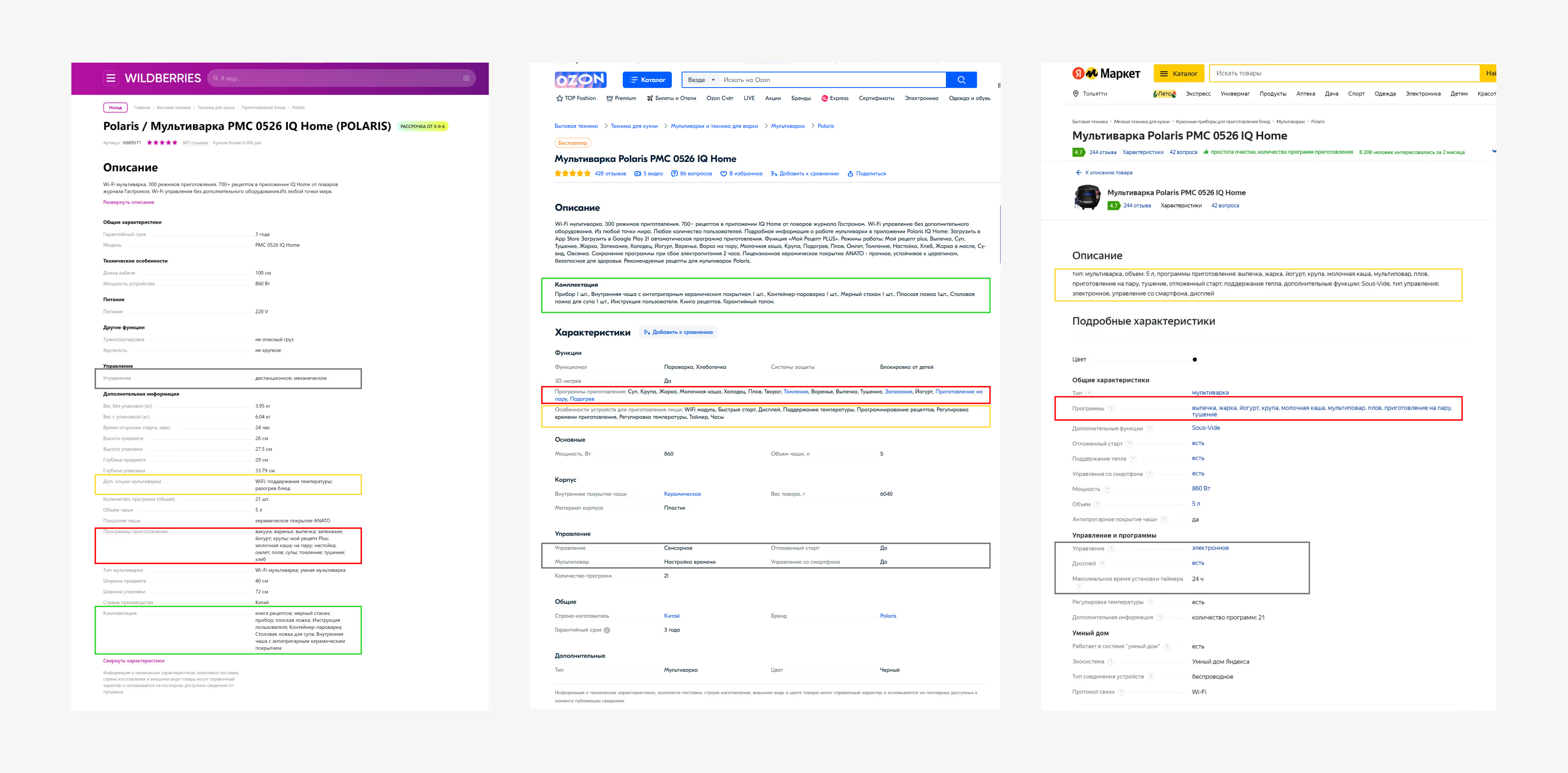According to HubSpot research→, 90% of shoppers consider answering product questions quickly to be a key factor when making a purchase decision. Moreover, they consider the answer to be quick in less than 10 minutes. The longer the wait time, the less likely you are to buy.
Another study, this time by McKinsey & Company →, shows that a service line worker spends about 20% of his working time searching for information or contacting other colleagues for help in solving specific requests.
But these are numbers. Sports will help us talk about what they mean for business in this article. The company is fictional, but the situations it faces are absolutely real.
Insufficient data in the product card = overloaded and slow support
Sports produces clothes under its own brand and sells its products on three marketplaces: Yandex Market, OZON and Wildberries. A separate manager is responsible for each sales channel. Half of the requests from potential buyers are typical and relate to specific product characteristics. For example, at what temperature can a T-shirt be washed? How warm is this hoodie? Is the jacket sleeve embroidered or printed?
Sports product cards on marketplaces are filled with only the most basic information. Managers would like to make them more complete, understandable and more salesable, but...
The manager responsible for OZON, for example, spends a lot of time every day looking for answers. He has to look at all documents, systems, correspondence, and call production facilities. Working out standard and complex questions at this stage is equally time-consuming to support.
It takes almost 100% of working time to find the information you need. As a result, the manager has almost no resources left for tasks that really increase sales: working on a product card on marketplaces, improving the product description and the accompanying visual.
The hidden complexity of simple goods
Even the simplest product at first glance — like a T-shirt or a pillow for sleeping — can have dozens of characteristics, in addition to color, size and materials of manufacture. All these characteristics are of interest to a potential buyer who, of course, does not want to risk money.
This means that in order to increase the likelihood of a purchase, the seller needs to take care of a number of nuances.
- Ensure that product information is up to date. If something changes in the product specifications, the corresponding adjustments should be immediately displayed on the product card on all sales channels.
- Provide as complete information as possible. Moreover, sometimes a basic product description requires several hundred parameters: dimensions, weight in and without packaging, color, size, main and additional materials, production parameters, seasonality, equipment, etc.
- Adapt product information for different sales channels. Different marketplaces have different requirements for organizing information, for example, for the format of illustrations or for recording overall dimensions. This is also important to consider.

- Eliminate data errors and inaccuracies. For example, in units of measurement and other quantitative indicators, manufacturer data, etc.
Doing this manually is difficult and time-consuming.
Firstly, because of the company's current data storage practices. Let's go back to Sports: different product characteristics are stored separately. This storage system was developed at the start of the business. Production information is in 1C, photos are in the corporate cloud, fabric care requirements are in tables, descriptions are in Google Docs, the dimensional grid is in the sewing shop files, etc. And there is only something in the employees' minds and in their correspondence.
The more possible sources of information, the longer it takes for a manager to search for it, especially if he has only recently joined the company and has not yet learned the shortcuts to where certain information is posted. This is inconvenient and exhausting, but to put data on all items together, you will have to spend even more time aggregating, updating and double-checking data.
Secondly, you also have to collect product cards on marketplaces manually. This increases the risk of errors or typos in product specifications, missing important fields, and confusion in names and images.
And despite the huge amount of time spent and effort, there is no qualitative improvement — the domino effect still works with the following cause-and-effect relationship:
- the product description on the website and marketplaces is incomplete, not always of high quality and relevant;
- customers are forced to request additional information, clarify details down to shades, compatibility with other products, millimeters in size, etc. ;
- this intensifies the flow of calls to the quality control and/or support service, chatbots, and the seller's hotline;
- the incoming line is overloaded — it processes clarifying questions, as well as negative information about goods on sales channels;
- At the same time, there is a negative attitude about the overload of customer support services and the protracted resolution of issues where the help of such a service is really indispensable.
The result: the seller's reputation suffers, sales do not grow even under favorable market conditions.
Could it be any other way? Yes, if you integrate a PIM system
So, we need to solve the problem of too many requests related to incomplete product descriptions on sales channels and to the scattered storage of information within the company.
The PIM system is precisely designed to aggregate, systematize and control the accuracy of all information about goods. Let's talk about three steps that will improve the quality of product cards and simplify the work of support managers.
Create a product card to collect all the information about each SKU in one place
In the PIM system, you can create a product card of any complexity. It can store both standard information (name, size range, materials, storage conditions, images, warranty period, colors, etc.) and more specific data (care instructions, temperature conditions, surface treatment method, etc.).
After the initial analysis, you can proceed to create a product card directly in the PIM system interface. For example, in Pimcore, the interface for creating a card and adding product properties looks like this.

The system allows you to add an unlimited number of fields (components) that characterize various product parameters. Here you can also set specific values for some properties (for example, product size), set up links between entities/directories (for example, between brand and product), set the necessary units of measurement (for example, product length and width), etc.
After conducting the initial analysis and directly placing the card in the interface, it's time to move on to the most important stage — systematizing product data within a single product card information model.
Build an information model to make the product description as complete as possible
The product card information model is all available information about a product that is used on sales channels and in internal business processes. The information model takes into account all the characteristics that are important for sales, marketing, production, logistics and procurement.
As correct as possible develop an information model for a manager three analytical questions will help.
- What do you know about the product? All the information about a specific SKU that is available to you as a seller.
- What should a customer know about the product? Marketing information and digital content that help customers make decisions about buying your product.
- What should other IT systems know about the product? Synchronization of internal processes between the company's divisions.
Each product card has one information model, and using the PIM system tools, the customer can regulate what information is transferred to sales channels and to what extent.

For example, for one of its customers — Polaris, a manufacturer of household and climate equipment — The KT.team has set up the transfer of information about 1,000. Brand SKU for four marketplaces→. For this purpose, child cards were created in each of the product cards for each of the marketplaces. The submissions take into account the requirements of the marketplaces themselves for organizing information. We have already shown what this looks like on the marketplaces themselves in the first illustration to this article.
.avif)
Set up data validation rules to minimize the risk of errors
Data validation means that at each stage of the card's life cycle, it must contain a specific set of values. And if some fields are empty or insufficiently filled in, the card cannot proceed to the next stage, for example, publishing on the marketplace. This way, it is possible to avoid human errors and data incompleteness.
If the product card on the marketplace must contain at least five photos, the PIM system will not allow a card with three photos to be published. If a required field is left blank (for example, a size has not been selected), the manager will also receive a notification that the card cannot be published.
Errors in product descriptions on sales channels are one of the most common problems often noted by KT.team customers, whose IT framework has not yet incorporated a PIM system.
The KT.team worked with a similar request, for example, on the Muztorg project. The team integrated the Pimcore system into the client's IT circuit→ to work with an assortment that includes over 120 thousand. SKU. The system automatically validates cards and individual fields, checking whether all required items comply with the specified rules. For example, a barcode must contain 13 digits without any extra characters, and if this criterion is not met, the card simply does not enter the system.
The result: customers see complete and correct information about products, the number of typical requests is decreasing
- All product information is in one place. To respond to customer requests, technical support just go to the product card and find the data you need in a couple of clicks. The reaction rate increases from a few hours to several minutes.
- The seller's customer support service is no longer overloaded with typical customer questions about color variations, dimensions, materials, and product configurations — now all this information is available on the website and on marketplaces.
- Support specialists have a resource to more quickly resolve really difficult issues from customers, where additional help is needed.
- It is easier for a buyer to make a decision to buy a product from you, since free access to the most complete and correct information strengthens the seller's confidence.
- The buyer receives exactly the product that is stated on the card: its actual appearance, dimensions and characteristics match those indicated on the sales channels, which has a positive effect on the number of repeat purchases and the degree of customer loyalty.








